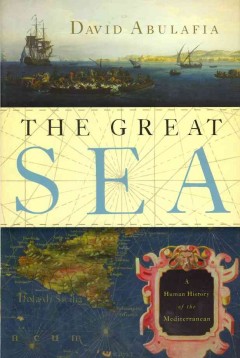by Jim
 Abulafia’s The Great Sea has been on my bedside table for what seems like years. Actually it has been years. It is just exactly what it says it is a history of the Mediterranean from prehistory to 2010. The thing that has been stopping me is that, minus end notes and index, it’s still 648 pages long. So it seemed like a time investment.
Abulafia’s The Great Sea has been on my bedside table for what seems like years. Actually it has been years. It is just exactly what it says it is a history of the Mediterranean from prehistory to 2010. The thing that has been stopping me is that, minus end notes and index, it’s still 648 pages long. So it seemed like a time investment.
A few weeks ago I decided I needed to get it off my bedside table, so I started in on it. It was a surprisingly easy read. Abulafia divides the book up into sections that are based on what he sees as distinct periods in the history of the Mediterranean. For example, there is a section that covers Medieval, Renaissance and Early Modern Mediterranean history. These sections are practically standalone books of their own. A reader could, if they wanted to, only read those sections that interested them, but I can recommend reading the whole thing.
Because he starts with prehistoric time, the opening sections of the book rely on archaeological evidence from all over the sea. It is very interesting to see how he and other scholars sift through all this data to come up with possible explanations for things. He sees the decline of a particular type of pottery in one location as a sign of declines in trade across the Mediterranean, because that type of potter came from another location. An added bonus is the book has lots of maps and pictures.
As the book progresses he does a good job of not only telling the larger history of the sea, politics, war, etc, but also incorporates sources showing the everyday interactions of individuals with the sea. One of these individuals was Muhammad iban Jubayr, a Muslim clerk from 12th century Granada. Jubayr, after a run-in with his boss, decides to take a pilgrimage to Mecca, which takes two years, and describes the experience in a diary. He describes a voyage with terrible weather, food shortages and experiences with customs officials that make standing in the security line at the airport look like a breeze. He also describes things of great beauty: On a Genoese ship bound for Sicily he describes the celebration of All Saints Day by covering the boat in candles.
So whether you read this book in bits and pieces, cover to cover, or only a part here and there, you’ll enjoy it thoroughly. I’d recommend it especially for anyone interested in ancient or medieval history.
